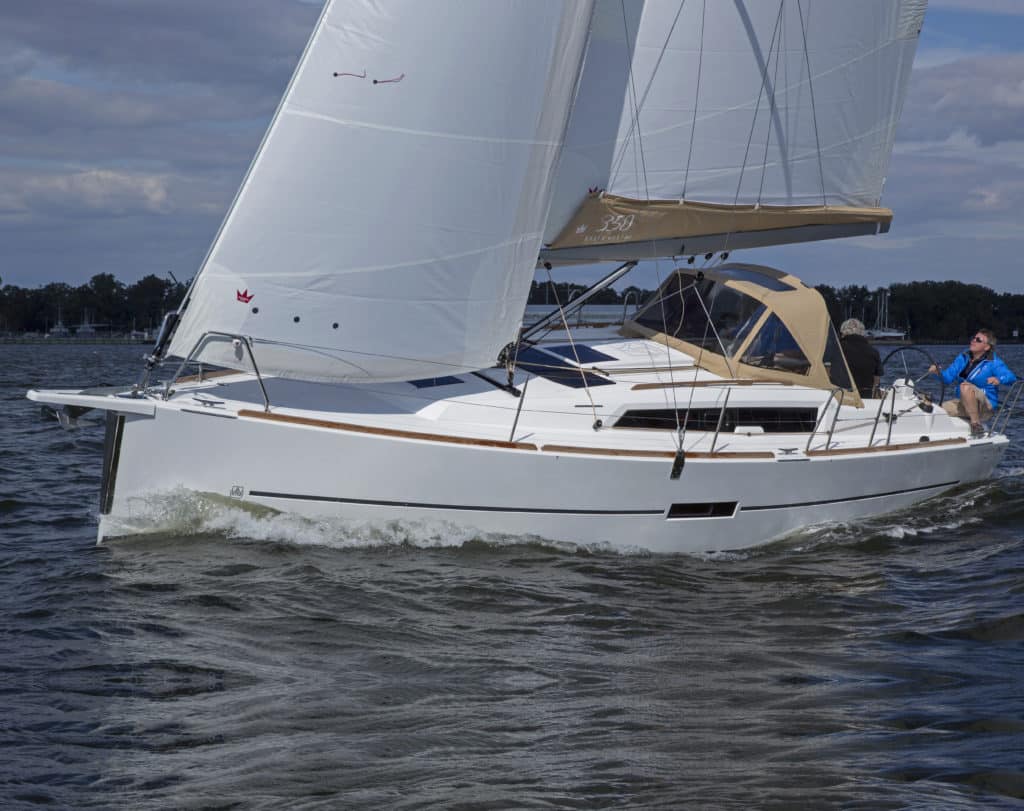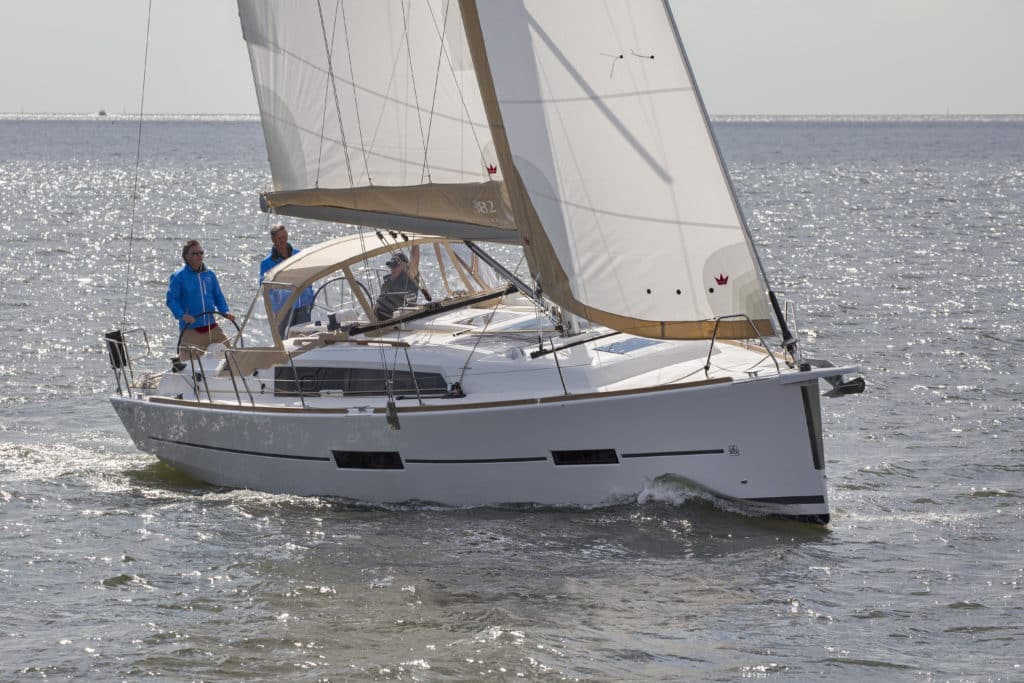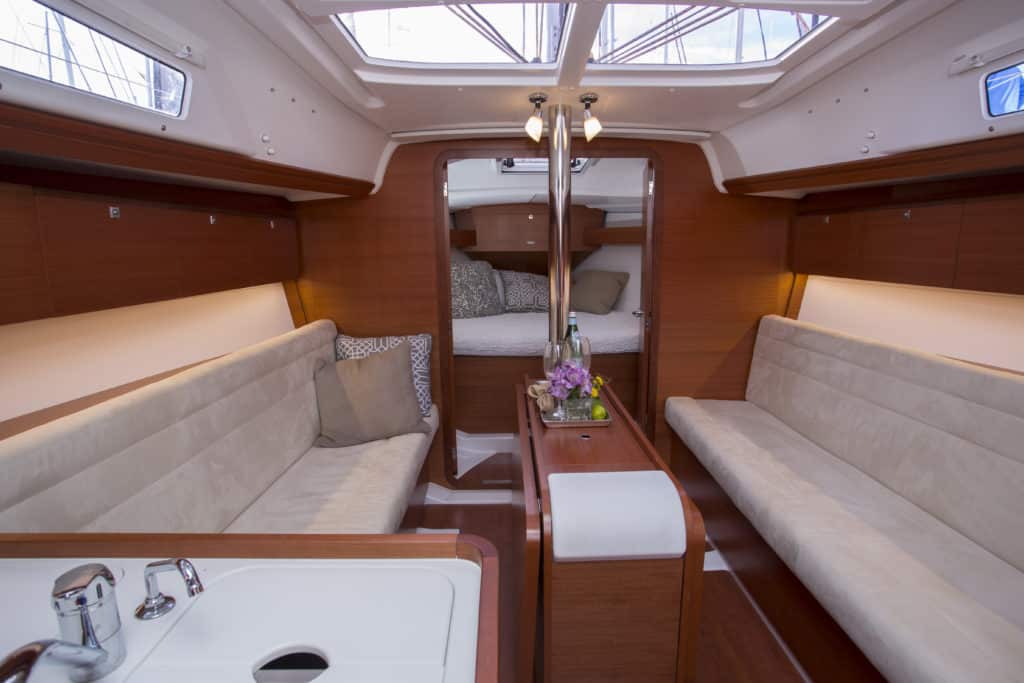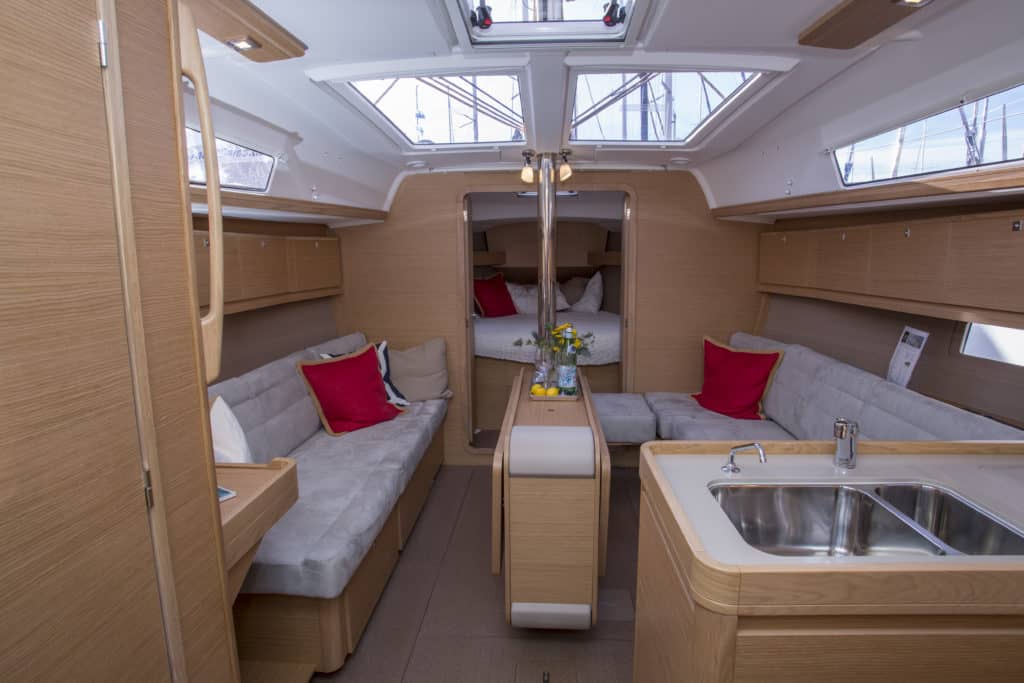
Last fall, during their final deliberations, the 2016 Boat of the Year judging team faced a dilemma. In the Midsize Cruiser category, the three-member panel had narrowed down the field to two boats from the same manufacturer, the French builder Dufour: the Grand Large 350 and 382. Which would they choose?
It was an extremely tough call because, in exterior matters especially, in terms of deck layout, hull form and profile appearance, the boats were essentially mirror images of each other. And that was a good thing. They were both very contemporary-looking, very attractive yachts. In fact, when the two Dufours were tied up beside each other at the U.S. Sailboat Show in Annapolis, Maryland, a dockside observer could easily conclude that he was suffering from double vision. (The fact that both boats were sporting identical beige dodgers and mainsail covers for their stacking, fully battened mains didn’t make things any easier.) They were that much alike.
At first glance, among the many similar features were the hard chines carried well aft to maximize beam and interior volume; the drop-down transoms and boarding/swim platforms; the twin helm stations and expansive cockpits with teak seats and floors, and nifty central folding tables; and the self-tacking 95 percent roller-furling jibs on dedicated tracks. Heck, the plumb bows of both boats were even outfitted with the same optional sprit for flying downwind and/or reaching sails. It was only later, when the boats were underway, that you could tell them apart by the portlights embedded in their hull: The 350 has but one, and the 382 has a pair.

Not surprisingly, they’re put together identically, with a hand-laminated, solid glass layup for the hulls that’s bonded to an internal structural grid, and decks that employ sandwich construction over an injected foam core. Each has an L-shaped bulb keel and a semielliptical rudder with a solid stainless-steel stock that anchors a blade fashioned using closed-cell epoxy foam. In other words, the builder has saved weight wherever possible, for performance reasons, but not at the expense of strength or reliability.
Anyway, those were some of the traits that made these two new Dufours unmistakable siblings. But there were some significant differences as well.
Let’s start with the 350, perhaps the first Dufour ever without a fixed backstay on the standard rig (though you can get one in the optional Grand Prix sail package). There’s also no traveler. (Both items would be key discussion points in BOTY deliberations.) The accommodation plan was likewise very straightforward. At the foot of the companionway, to port, there’s a nice galley and a private cabin aft. To starboard, the nav station fronts a large head compartment. Going forward, a pair of settees flanks a robust folding dining table, and the owner’s cabin in the bow is accessed through double doors. It’s simple but effective.
On the other hand, you can really soup up, customize and accessorize the 382. There are no less than a half-dozen different interior layouts, with either a traditional L-shaped galley or a straight-line one; two or three cabins; and one or two heads. You can get either a very ICW-friendly short rig (55 feet 3 inches) or, if your plans include terrorizing your local club-racing fleet, the optional tall stick (61 feet 10 inches). Accordingly, both in-mast furling mains and traditional, classic mainsails are available, and you can choose between a self-tacking jib or an optional overlapping genoa. Furthermore, if offshore forays are in the cards, you can even specify an inner forestay and a staysail. Altogether, there are eight different sail-plan configurations from which to choose.

So with all those many options available on the 382, one might think it would be the hands-down winner. But then the judges went sailing. And things became much more complicated. As judge Tim Murphy noted: “Every year I take my own poll after our dockside inspections regarding who I think the winners will be. And every year I change my mind on a few after our sea trials. And that’s what happened here. I really enjoyed being aboard these boats once they were in motion.”
First up was the 350, tested in about 10 to 15 knots of breeze. The lack of a backstay actually proved beneficial in one aspect, as the helmsman had a lot of room to get comfortable behind the twin wheels. Short-tacking up the Severn River past the U.S. Naval Academy, the boat was responsive and nimble, making better than 6 knots closehauled. The vang proved very effective in controlling the mainsail; in the brief moments that the boat felt overpowered, easing it instantly got the boat back on her feet. “It just felt fun to sail this boat,” said Murphy. “It was a lovely sail.”
Next came the 382, sailed in slightly puffier winds. The split backstay, which helps the ergonomic flow through the cockpit from the transom to the companionway when anchored, terminates at the extreme aft quarters of the yacht; we discovered it was much more comfortable to steer from a windward position rather than tucked down to leeward. But once you were locked in, the 382 was a joy to drive, with fingertip control. The German-style double-ended mainsheet, led to winches just forward of the helmsman to port and starboard, provided quick and easy trimming control, as did the wide traveler, positioned on the coachroof just forward of the dodger. Like its sister ship, the 382 easily trucked to weather at better than 6 knots. (It’s worth noting that both models we tested were fitted with shoal keels; the judges would opt for the available deeper versions to reduce leeway when hard on the breeze.)

“I think there’s a trend in the Dufour line, at least in this size range, to make it a really easy boat for a couple to operate,” said judge Ed Sherman. “It certainly worked for me. With the self-tacking jib, once everything was trimmed up correctly, you could just slam it around on quick tacks very easily. It actually makes it a very good boat to singlehand. Overall, I was very happy with it.”
So, as mentioned at the outset, when it came time to cast their ballots, the judges faced a quandary. All of them considered the 350 a sweet little cruising boat, but they also appreciated the 382’s increased volume, rig and accommodation options, and its better, beefier sailhandling controls. Ultimately, it came down to a simple question: Was the bigger boat, costing roughly $50,000 more than the more compact model, worth the extra expenditure?
In the end, their answer was yes, and the Dufour 382 was named 2016’s Best Midsize Cruiser. But here’s a little secret from someone who watched them agonize over their decision: In his heart of hearts, I reckon each judge would be just as happy with a Dufour 350 in his slip.
350 GL Specs:
LOA: 33’6″ (10.28 m)
LWL: 29’6″ (9 m)
Beam: 11’6″ (3.54 m)
Draft: 6’3″/5’1″ (1.9/1.55 m)
Sail Area (100%) 592 sq. ft. (55 sq m)
Ballast: 3,417 lb. (1,550 kg)
Displacement: 12,509 lb. (5,674 kg)
Ballast/Displacement: 0.27
Displacement/Length: 214
Sail Area / Displacement: 17.8
Water: 58 gal. (220 l)
Fuel: 42 gal. (160 l)
Holding: 14 gal. (53 l)
Mast Height: 47’6″ (14.47 m)
Engine: 19 hp Volvo (saildrive)
Designer: Umberto Felci/Dufour Yachts Design Team
Price: $165,000
382 GL Specs:
LOA: 36’10” (11.23 m)
LWL:32’5″ (9.9 m)
Beam: 12’7″ (3.85 m)
Draft: 6’4″/5’4″ (1.9/1.6 m)
Sail Area (100%): 623 sq. ft. (58 sq m)
Ballast: 4,299 lb. (1,950 kg)
Displacement: 15,564 lb. (7,060 kg)
Ballast/Displacement: 0.27
Displacement/Length: 202
Sail Area/Displacement: 16.33
Water: 95 gal. (360 l)
Fuel: 53 gal. (200 l)
Holding: 12 gal. (45 l)
Mast Height: 55’3″/61’10” (16.82/18.86 m)
Engine: 29 hp Volvo (saildrive)
Designer: Umberto Felci/Dufour Yachts Design Team
Price: $210,000
Dufour Yachts
352-871-0362
dufour-yachts.com
Herb McCormick is CW’s executive editor.








